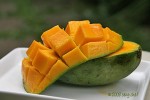Banana Republic’s Low Fruit Trade
Indonesia wants to export more goods - such as bananas - to Australia.
One of the more unusual events on the sidelines of the recent East Asia Summit in Bali (apart from Paris Hilton's visit) was a reported conversation between politicians and trade representatives of Indonesia and Australia, which occurred at a meeting of the Indonesia Australia Business Council in Kuta.[1]
Indonesians Go Bananas Rather than raising topics of mutual concern such as the mistreatment of Australian cattle in Indonesian abattoirs, Indonesian Ambassador to Australia Primo Alui Joelianto (left) lamented Indonesia's low level of exports to Australia.
Rather than raising topics of mutual concern such as the mistreatment of Australian cattle in Indonesian abattoirs, Indonesian Ambassador to Australia Primo Alui Joelianto (left) lamented Indonesia's low level of exports to Australia.
Using uncharacteristically blunt language - especially from a country that once accused its southern neighbour of "megaphone diplomacy"[2] - Mr Joelianto said:
There must be something wrong here.
The ambassador blamed excessive Australian trade barriers, quarantine regulations and anti-dumping laws. To back up his case, he quoted the following statistics:
- Indonesia exports half as much fish (2.5%) to Australia as its more distant neighbours Thailand (5.2%) and Singapore (5.1%), the latter a country with almost no territorial waters.
- Indonesia is third in palm oil exports behind Malaysia (90%) and Singapore, a country with no palm-oil plantations.
 This view was seconded by Ian Siagian (right), a member of parliament from PDIP (Indonesian Democratic Party of Struggle). He asked:
This view was seconded by Ian Siagian (right), a member of parliament from PDIP (Indonesian Democratic Party of Struggle). He asked:
If Thai fruits, Philippine fruits and even Pakistani mangoes can enter Australia, why not Indonesian mangoes and bananas?
 The Australian Trade Minister, Dr Craig Emerson (left), replied that he did not know why Indonesian fruit was banned, but he would ask and tell them the answer. He also pointed out that Australian quarantine processes are fair and impartial, and politicial leaders like himself cannot intervene or interfere.
The Australian Trade Minister, Dr Craig Emerson (left), replied that he did not know why Indonesian fruit was banned, but he would ask and tell them the answer. He also pointed out that Australian quarantine processes are fair and impartial, and politicial leaders like himself cannot intervene or interfere.
Indonesian Fruit in Australia – The Case For
A business case could certainly be made for Indonesian fruit to be allowed to enter Australia.
 Earlier this year, Cyclone Yasi wiped out most of Australia's banana crop in north Queensland. This was then followed by below-average temperatures, hindering the growth of new bananas[3]. As a consequence, bananas were few and the price skyrocketed to $A17 (Rp150 000) per kg.
Earlier this year, Cyclone Yasi wiped out most of Australia's banana crop in north Queensland. This was then followed by below-average temperatures, hindering the growth of new bananas[3]. As a consequence, bananas were few and the price skyrocketed to $A17 (Rp150 000) per kg.
Five years ago, bananas again were either very expensive or not available in the aftermath of Cyclone Larry.
This compares with the average price of Rp15 000-Rp35 000 ($A2 to $A4) in an Indonesian supermarket, and even less at the local market or warung, where the author can buy 3 bananas for Rp2000 ($A0.25).
 Indonesia is certainly blessed with a relative abundance of bananas; it is home to 200 different types of banana trees, 33 of which produce edible fruit. Perhaps Indonesian bananas could be allowed into Australia when local supplies are depleted/reduced. A reliable and continued supply of bananas would also help Australian farmers in the long term; it would provide a continued demand for bananas until Australian farmers' banana trees have regrown, rather than a slow increase from near zero.
Indonesia is certainly blessed with a relative abundance of bananas; it is home to 200 different types of banana trees, 33 of which produce edible fruit. Perhaps Indonesian bananas could be allowed into Australia when local supplies are depleted/reduced. A reliable and continued supply of bananas would also help Australian farmers in the long term; it would provide a continued demand for bananas until Australian farmers' banana trees have regrown, rather than a slow increase from near zero.
A similar argument could also be used to allow the importation of fresh fruits that are seasonal in Australia, but available year-round in Indonesia. Some examples are:
 Watermelons come in red and yellow/champagne varieties, either with or without seeds, all at a very reasonable price.
Watermelons come in red and yellow/champagne varieties, either with or without seeds, all at a very reasonable price.
 Some enterprising locals sell fresh pineapples to Australian tourists at the Kuta beaches in Bali and Lombok for as little as Rp5000 ($A0.60) a pineapple; why not let them sell pineapples to their home country?
Some enterprising locals sell fresh pineapples to Australian tourists at the Kuta beaches in Bali and Lombok for as little as Rp5000 ($A0.60) a pineapple; why not let them sell pineapples to their home country?
 Not a tropical fruit per se, but strawberries can be grown in the cooler climate of the hills in West and East Java. A punnet can cost less than $A1. Strawberry juice is also widely available.
Not a tropical fruit per se, but strawberries can be grown in the cooler climate of the hills in West and East Java. A punnet can cost less than $A1. Strawberry juice is also widely available.
 Indonesian mangoes are also seasonal; however, the season is longer (and the fruit much cheaper) than in Australia. Mr Siagian might like to suggest that Indonesian mangoes be made available in Australia outside their own season, thereby reducing the likely opposition of Australian mango famers. Australian consumers might be confused at first by the green skin of Indonesia's most popular "harum manis" variety; Australian mangoes' skin is usually red and/or yellow.
Indonesian mangoes are also seasonal; however, the season is longer (and the fruit much cheaper) than in Australia. Mr Siagian might like to suggest that Indonesian mangoes be made available in Australia outside their own season, thereby reducing the likely opposition of Australian mango famers. Australian consumers might be confused at first by the green skin of Indonesia's most popular "harum manis" variety; Australian mangoes' skin is usually red and/or yellow.
More opinions wanted
It is not known whether the Indonesian Ambassador and Mr Siagian were expressing their own opinions in this area, or the view of the government.
But what do you think?
- Should the Indonesian Trade Minister, Gita Wiryawan, try to obtain permission to export fruit to Australia?
- Do you think the Australian government would agree
or say "Get your hands off my bananas"? - Would Australians be willing to buy imported Indonesian fruit
or would they go bananas?
Banana Republic’s Low Fruit Trade is brought to you by Indonesia Matters, where you can book flights in Indonesia, and features listings of Indonesian hotels, like Kuta hotels, Sanur hotels, hotels in Jakarta and near Jakarta airport, and more.
Link to full article



Comments
Post a Comment